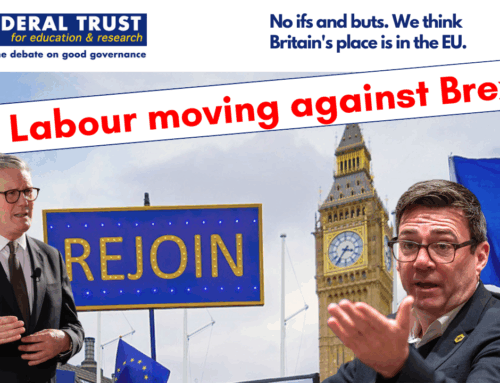
by Dr Kirsty Hughes
Director of the Scottish Centre on European Relations
5th November 2019
This article was first published by SCER.
The election in Scotland looks set to be about both independence and Brexit – more so than in 2017. And while the pro-union parties – the Tories, Labour and LibDems – are usually pretty confident in their anti-independence lines, this looks like being a more tricky pitch this time, at least for both Tories and Labour. Meanwhile, the SNP – which was rather reticent both on independence and on halting Brexit in 2017 (despite Nicola Sturgeon having called for another independence referendum that March) – now looks set to argue strongly on both, with independence to the fore.
The Polls
The polls have shown for some time that the SNP is likely to improve on its 2017 performance, pushing its number of MPs back up over the 40 mark or even to 50 MPs or more, out of 59. The big question is whether and how many seats the Tories and Labour lose – having jumped from one each in 2015 to 13 and 7 MPs respectively in 2017. The LibDems with 4 seats are likely to hold on to these, perhaps adding one or more.
The more seats the Tories lose in Scotland, the more Johnson needs to add in England and Wales if he is to win a majority. And while Labour will push to hang on to some of its 7 seats, the chances of some sort of pact, however informal, between Labour and SNP, if Labour should form the largest party at Westminster after 12th December, is quite high. In that sense, the Tories have more to lose in Scotland than Labour.
Recent polls have shown an increase in support for independence, a belated Brexit bounce of sorts with some remain voters switching from ‘no’ to ‘yes’. A Panelbase poll for the Sunday Times in October, found support for and against independence was tied at 50% each. That same poll also found support for remain at 67% (up from the 62% vote at the 2016 referendum). And only a quarter of those who voted ‘yes’ to independence in 2014 now back leave according to this poll.
How people’s views on independence and Brexit come together in their voting choices on 12th December may depend on various factors. But of the 33% in Scotland who still back leave, about one third of those back independence – so the Tories best hopes for votes may lie in that 22% or so of the Scottish electorate who are pro-Brexit and anti-independence.
Brexit and Independence Arguments Inter-twine
There will be a whole range of arguments about the costs and benefits of independence between the pro- and anti-independence sides (the currency issue, the deficit and much much more). But Brexit has transformed the arguments about independence and the EU compared to 2014. These debates have had plenty of airtime since the 2016 Brexit vote but will now be tested again strongly in the coming weeks.
The SNP has argued repeatedly that Scotland is being taken out of the EU against its will, has not been consulted in any serious way over Brexit, and its offers of compromise (on a ‘soft’ UK Brexit or keeping Scotland in the EU’s single market) have been ignored. SNP politicians point repeatedly to Ireland’s position in the EU – the other EU26 rallying to its defence throughout the Brexit talks – as a realistic and positive aspiration. They also point to the fact that there was no suggestion in the 2014 independence campaign that the UK would be leaving the EU – rather, misleadingly, it was argued at the time that an independent Scotland would find it very hard to join the EU. The mood music from Brussels on an independent Scotland joining the EU is now much less negative.
The SNP have backed a second referendum on Brexit but look like putting much more emphasis on independence than on halting Brexit in this election – though both arguments will surely be made. One issue that has not come to the fore recently is the question of whether an independent Scotland should be in the EU or join the European Economic Area alongside Norway. The example of Ireland, and the Brexit debate, has resulted instead in much more emphasis on the SNP’s policy position of independence in the EU. But if Johnson were to win the election, go ahead with Brexit and leave the EU’s customs union, the EU versus EEA debate could erupt again, not least in terms of the border question (as discussed more below).
The LibDems are the one party clearly arguing against leaving either union – the EU or the UK – and have been consistently in favour of a people’s vote from early on after the 2016 result. But their support for a second EU referendum but not another independence referendum is not entirely consistent. Jo Swinson usually defends the discrepancy by emphasising her desired outcome of each referendum (remain, ‘no’ to independence) rather than facing up to any more complex argument about why, in her view, politically a people’s vote is a good idea but a second independence referendum is not.
In contrast, the SNP support both another EU vote and another independence vote – but want to leave one union while stay in the other. The SNP argue that these are two different unions – which is certainly the case in the sense that the EU is a union of sovereign states, the UK is not. But some of the impacts of Brexit (notably on borders) read across to independence too.
There is a big chunk of voters in Scotland who would like to remain in the EU and the UK. The key question here is how many will vote for the LibDems, given their low likelihood of gaining many seats in Scotland – and the extent to which these voters prioritise remaining in the UK versus remaining in the EU, when deciding where to place their vote in marginal seats if the LibDems are not serious challengers. Apart from the LibDems, only the pro-independence SNP and Green parties are clear remain parties. The choice will be stark for some.
The Tories face trickier challenges in their arguments. Brexit is a positive, democratic path to follow, they say – the Scottish Tories cleaving to Johnson’s ‘lets get Brexit done’ spin (even though it will be far from done if the UK leaves the EU by January with the main future relationship still to negotiate from a position of weakness). But, they add, Brexit has not been straightforward and leaving a much older union would be even more difficult. In the face of the major and damaging systemic change that Brexit involves, backing it nonetheless (invoking unrealistic sunlit uplands) while critiquing independence is a messy argument and one that will appeal to just a sub-set of Scottish voters.
And it gets trickier. Johnson’s deal with the EU gives Northern Ireland a special status effectively inside the EU’s customs union and within the single market for goods (but not services). There will be a customs and regulatory border down the Irish Sea. For the Tories, the argument that Scottish independence would result in economic damage from leaving the UK single market and mean a Scotland-England border is rather weakened by the fact that Northern Ireland will not be part of a renewed UK single market after Brexit. Instead, it will be a British single market with an internal border between Britain and Northern Ireland.
So, if the Johnson Brexit deal goes through (to be followed by a future UK-EU free trade deal), there will be a hard border between Britain and the EU, and between Britain and Northern Ireland. And the Tories will have to argue both that these two borders are fine and not economically damaging (contrary to all evidence on trade barriers) while arguing a hard border with Scotland is one key reason to reject independence. And yes, Scotland does three times more trade with the rest of the UK than the EU – but so does Northern Ireland and 44% of UK exports are to the EU.
But Tory inconsistency doesn’t let the SNP off the hook on the border question – though it may help them in debates. This has always been a Brexit conundrum for the pro-independence campaign: Brexit helps to make the case for another independence referendum but also makes the border issue much trickier to deal with than if both Scotland and the rest of the UK are in the EU, its single market and customs union.
Finally, Labour faces a tough battle to retain seats in Scotland. Its confused Brexit fudge for the last three years has done it little good. Rather than go into the election as a clearly remain party, the line, instead, is that Labour will negotiate a better Brexit (something in fact rather similar to Theresa May’s deal, though Labour would deny this) and then put it to a referendum but only deciding at that point whether it likes the deal it has negotiated or will back remain (this has raised eyebrows in Brussels too as a ‘strategy’). Scottish Labour claims that it is pro-remain but in the face of the agreed Labour position this looks weak apart from for one or two individual candidates – notably Ian Murray MP who has consistently backed remain and a people’s vote despite Labour’s changing Brexit fudges.
Labour’s opposition to independence has also been dented in recent months by both Jeremy Corbyn and John McDonnell saying they wouldn’t stand in the way of another independence referendum (other than perhaps on timing). This has, to put it mildly, not been welcomed by Scottish Labour. Opposition to independence but openness to a referendum, and a fudge on Brexit is not an obvious way to win votes in Labour’s one-time heartland – though it may pave the way to a Labour-SNP deal of sorts, if Labour manages to get enough seats overall.
Where next for the UK and Scotland?
The two most likely outcomes for the UK election are either a Tory majority or a hung parliament. In a hung parliament, the question will be whether Labour can form some sort of minority administration. With the Article 50 extension running out just six short weeks after the election, the UK will be set either to go ahead with a Johnson-style Brexit or to ask for another extension, perhaps to negotiate a Labour Brexit deal and hold another EU referendum.
In the latter scenario, the SNP – very likely with significantly more MPs than currently – will surely bargain hard for a section 30 order and a Labour commitment to allowing another independence vote. The question then would be whether such a SNP-Labour deal would upset any necessary LibDem support for a minority government. That LibDem support looks pretty tough for Corbyn to get in any event – Swinson will keep denying she would give it throughout the election. The LibDems might perhaps back a Corbyn government on moving to a second EU referendum – but if they pulled the plug after that, not least in the face of a Corbyn government potentially agreeing a second independence referendum, then we could be back again in election territory. So unless Labour and the SNP had a majority between them, the future scenarios from a hung parliament look varied indeed.
In the former scenario, of Brexit going ahead and a Johnson majority government, the SNP will certainly repeat its demand (that it anyway looks like making before 12th December) for a section 30 order. In the face of a Johnson ‘no’, the political dynamics will get interesting indeed though Nicola Sturgeon may then set her sights on a further election victory in the Scottish parliament election in 2021.
One thing is clear. After 12th December, neither the Brexit debate nor the independence debate will have gone away. And the uncertainties of Brexit will continue to plague UK politics.




